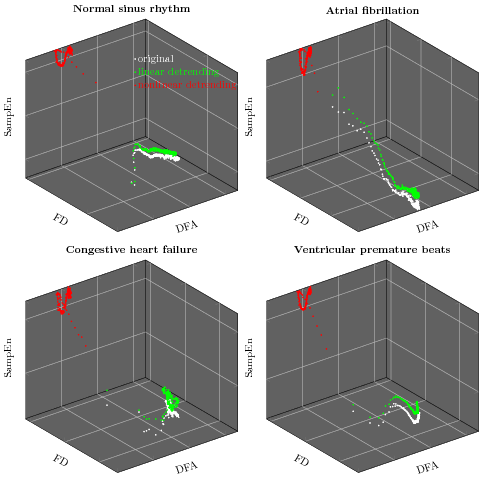Section: New Results
Nonlinear trend removal should be carefully performed in heart rate variability analysis
Participants : Binbin Xu, Oriol Pont, Hussein Yahia, Rémi Dubois.
Background : In Heart rate variability analysis, the rate-rate time series suffer often from aperiodic non-stationarity, presence of ectopic beats etc. It would be hard to extract helpful information from the original signals. Problem : Trend removal methods are commonly practiced to reduce the influence of the low frequency and aperiodic non-stationary in RR data. This can unfortunately affect the signal and make the analysis on detrended data less appropriate. Objective : Investigate the detrending effect (linear & nonlinear) in temporal / nonliear analysis of heart rate variability of long-term RR data (in normal sinus rhythm, atrial fibrillation, congestive heart failure and ventricular premature arrhythmia conditions). Methods : Temporal method : standard measure SDNN; Nonlinear methods : multi-scale Fractal Dimension (FD), Detrended Fluctuation Analysis (DFA) & Sample Entropy (SampEn) analysis.
Results : The linear detrending affects little the global characteristics of the RR data, either in temporal analysis or in nonlinear complexity analysis. After linear detrending, the SDNNs are just slightly shifted and all distributions are well preserved. The cross-scale complexity remained almost the same as the ones for original RR data or correlated. Nonlinear detrending changed not only the SDNNs distribution, but also the order among different types of RR data. After this processing, the SDNN became indistinguishable between SDNN for normal sinus rhythm and ventricular premature beats. Different RR data has different complexity signature. Nonlinear detrending made the all RR data to be similar, in terms of complexity. It is thus impossible to distinguish them. The FD showed that nonlinearly detrended RR data has a dimension close to 2, the exponent from DFA is close to zero and SampEn is larger than 1.5 – these complexity values are very close to those for random signal. Conclusions : Pre-processing by linear detrending can be performed on RR data, which has little influence on the corresponding analysis. Nonlinear detrending could be harmful and it is not advisable to use this type of pre-processing. Exceptions do exist, but only combined with other appropriate techniques to avoid complete change of the signal's intrinsic dynamics.
One submitted publication.



